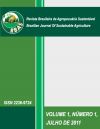STRUCTURE AND NUTRITIVE VALUE OF DEFERRED PASTURE OF BRACHIARIA DECUMBENS CV. BASILISK DURING THE GRAZING PERIOD
DOI:
https://doi.org/10.21206/rbas.v1i1.21Abstract
The experiment aimed to understand the effect of grazing period on morphology and nutritive value of deferred Brachiaria decumbens cv. Basilisk pasture and on hand-plucking sample with cattle. Subdivided plots were used according to a randomized block design with two replicates. Four grazing periods (1, 31, 57 and 88 days) and two forage samples (available in pasture (AP) and obtained by hand-plucking (HP)) were studied. The live leaf laminae (LLL), potentially digestible neutral detergent fiber (PDNDF), potentially digestible dry matter (PDDM) and crude protein (CP) levels were higher and dead leaf laminae (DLL), and dead stem (DS), neutral detergent fiber (NDF) and indigestible NDF percentages were lower in sample of HP in relation to forage AP. The grazing period decreased linearly the LLL, PDNDF, PDDM percentages, as well as increased linearly DS and indigestible NDF levels in forages. The potential selectivity indexes (PSI) of LLL and indigestible NDF increased linearly with grazing period. The PSI of live stem was smaller and the PSI of CP was higher in interim periods of grazing. The reduction in deferring period results in B. decumbens with better morphological composition and nutritional value, which favors the animal selectivity.Downloads
Download data is not yet available.
Downloads
Published
2011-07-01
How to Cite
Manoel Eduardo Rozalino Santos, Dilermando Miranda da Fonseca, Marcela Azevedo Magalhães, Simone Pedro da Silva, Daniel Rume Casagrande, Éric Márcio Balbino, & Virgilio Mesquita Gomes. (2011). STRUCTURE AND NUTRITIVE VALUE OF DEFERRED PASTURE OF BRACHIARIA DECUMBENS CV. BASILISK DURING THE GRAZING PERIOD. Brazilian Journal of Sustainable Agriculture, 1(1). https://doi.org/10.21206/rbas.v1i1.21
Issue
Section
Artigos
License
1. Proposta de Política para Periódicos de Acesso Livre
Autores que publicam nesta revista concordam com os seguintes termos:
Autores mantém os direitos autorais e concedem à revista o direito de primeira publicação, com o trabalho simultaneamente licenciado sob a Licença Creative Commons Attribution que permite o compartilhamento do trabalho com reconhecimento da autoria e publicação inicial nesta revista.











